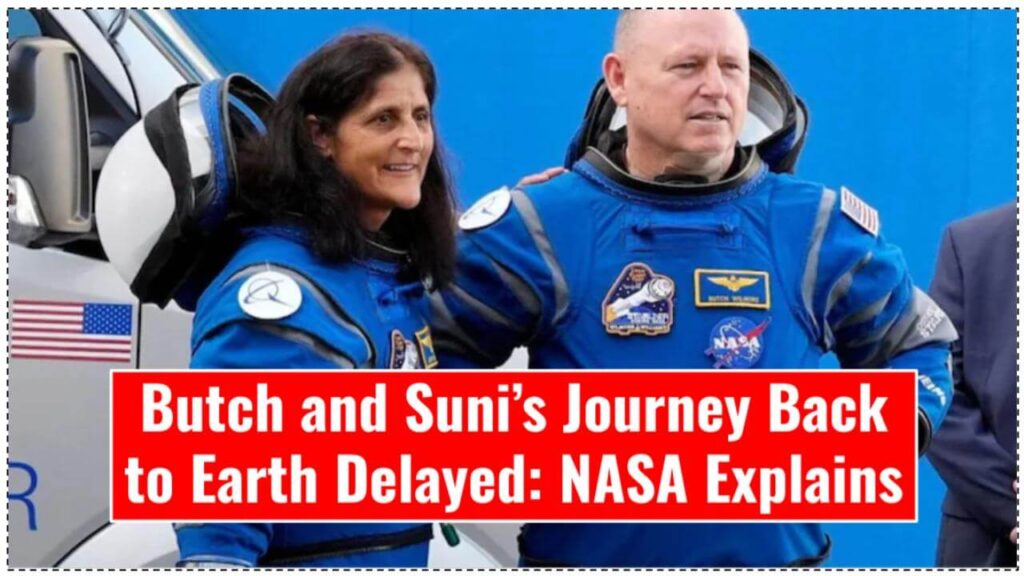
Sunita Williams Journey Back to Earth Delayed: NASA astronauts Barry “Butch” Wilmore and Sunita “Suni” Williams have become familiar names in space exploration. However, their much-anticipated return to Earth from the International Space Station (ISS) has been delayed once again, with NASA citing technical challenges and prioritizing safety as key factors. Let’s explore what led to this decision, what it means for the astronauts, and the lessons it offers for the future of space exploration.
Sunita Williams Journey Back to Earth Delayed
| Key Points | Details |
|---|---|
| Astronauts | Barry “Butch” Wilmore and Sunita “Suni” Williams |
| Planned Return Date | Initially early 2025, now delayed until late March 2025 |
| Cause of Delay | Issues with Boeing’s Starliner spacecraft, including thruster failures and helium leaks |
| Current Status | Integrated into ISS Expedition 71/72; contributing to research and station maintenance |
| Next Steps | Awaiting readiness of NASA’s SpaceX Crew-10 mission for their return |
| Source of Information | NASA and updates from Reuters |
Butch Wilmore and Suni Williams’ delayed return highlights the challenges and intricacies of modern space exploration. NASA’s unwavering focus on safety and collaboration ensures that every mission contributes to the advancement of human knowledge and technology. While delays can be disheartening, they remind us of the extraordinary care and precision required for journeys beyond Earth.
The lessons learned from this mission will shape the future of space exploration, paving the way for longer, safer, and more ambitious missions. As humanity continues to reach for the stars, patience and perseverance remain our most valuable tools.
Why the Delay? Understanding the Starliner Setbacks
The delay centers around Boeing’s CST-100 Starliner, a spacecraft designed to transport astronauts to and from the ISS. Originally intended for a one-week test mission, the spacecraft encountered significant challenges:
- Thruster Failures: Critical thrusters malfunctioned during initial testing, compromising maneuverability.
- Helium Leaks: Multiple leaks were detected in the propulsion system, raising safety concerns for the crew.
These issues reflect the intricacies of developing advanced spacecraft. Engineers must balance cutting-edge technology with rigorous safety protocols, a process that often reveals unexpected challenges during testing. Boeing’s ongoing work to resolve these issues demonstrates the complexity and importance of ensuring mission readiness.
Given these issues, NASA decided not to use the Starliner for Wilmore and Williams’ return. Safety remains a cornerstone of NASA’s operations, and the agency’s decision underscores its commitment to protecting astronauts.
What Does This Mean for the Astronauts?
While delays can be frustrating, both astronauts are taking the extended mission in stride. Here’s how they’re adapting:
Extended Role on the ISS
Wilmore and Williams are now part of ISS Expedition 71/72, where they play a pivotal role in:
- Conducting Groundbreaking Experiments: Their extended stay allows them to participate in long-term studies on microgravity’s effects on the human body, as well as experiments involving advanced materials and biological processes.
- Station Maintenance and Upgrades: From updating essential life-support systems to assisting in robotic repairs, their efforts ensure the ISS remains operational and efficient.
- Mentoring New Crew Members: Experienced astronauts like Wilmore and Williams offer invaluable insights and training to newer crew members, facilitating smoother operations and transitions on the station.
Maintaining Physical and Mental Health
Staying in space for extended periods demands rigorous physical and mental fitness. Astronauts follow daily exercise routines to combat muscle loss and bone density reduction in microgravity. They also prioritize mental health through scheduled recreational activities and regular video calls with loved ones.
NASA’s psychological support teams play a crucial role in ensuring that astronauts remain resilient during their extended missions. From curated entertainment to mindfulness training, every aspect of their well-being is carefully monitored and supported.
How NASA Plans for Sunita Williams Journey Back to Earth
NASA’s stringent protocols for astronaut safety are at the heart of this delay. Here’s how the agency ensures safe missions:
Thorough Testing of Spacecraft
Before any mission, spacecraft undergo rigorous testing. For the Starliner, NASA and Boeing are working together to address:
- Propulsion System Integrity: Engineers are re-evaluating the thrusters to ensure they can handle unexpected conditions.
- Redundancies for Critical Systems: By adding backup systems, NASA minimizes risks associated with potential failures.
Collaboration with Trusted Partners
SpaceX, a long-standing partner, will play a role in bringing Wilmore and Williams home. NASA’s Crew-10 mission, featuring SpaceX’s Dragon spacecraft, is expected to support their safe return. The Dragon spacecraft has a proven track record, having successfully completed multiple crewed and cargo missions to the ISS.
This collaboration highlights NASA’s strategy of leveraging expertise from private companies to enhance mission success. By diversifying partnerships, the agency ensures a broader range of solutions to potential challenges.
Ongoing Risk Assessments
NASA’s mission planners conduct continuous risk assessments, adapting protocols to account for evolving conditions. These assessments guide decisions on launch schedules, equipment readiness, and astronaut health, ensuring every factor aligns with safety standards.
Lessons for the Future of Space Exploration
The challenges faced by the Starliner mission highlight important lessons for future space endeavors:
Redundancy is Key
Spacecraft must have fail-safes for critical systems. Engineers are integrating multiple layers of protection into spacecraft designs, ensuring that even in the event of primary system failures, secondary systems can maintain mission integrity.
Collaboration is Essential
NASA’s partnerships with Boeing and SpaceX exemplify the importance of teamwork in addressing challenges. By pooling resources and expertise, the space industry can overcome obstacles more effectively.
Patience Pays Off
Prioritizing safety over speed ensures mission success and builds trust in space exploration. Each delay offers an opportunity to refine processes, address vulnerabilities, and strengthen future missions.
Long-Duration Missions as the New Normal
Extended stays aboard the ISS are becoming increasingly common. These missions provide valuable insights into the physical and psychological challenges of long-term space travel, preparing humanity for ambitious goals like Mars exploration.
Bird Flu Outbreak in California: What You Need to Know Right Now!
The December 2024 Full Moon: Why the ‘Cold Moon’ Looks So Different
Frequently Asked Questions (FAQs)
Why is the Starliner’s failure significant?
The Starliner was envisioned as a reliable spacecraft for transporting astronauts. Its issues emphasize the complexity of spacecraft development and the need for exhaustive testing.
How long have Wilmore and Williams been on the ISS?
They have been aboard the ISS since June 2024. Their return was originally scheduled for early 2025 but has now been postponed to late March 2025.
What are the benefits of an extended stay on the ISS?
Longer missions allow astronauts to contribute more significantly to scientific research, perform essential maintenance, and share insights with incoming crews.
When will the Crew-10 mission launch?
The Crew-10 mission is slated for late March 2025, pending final preparations.
How does NASA ensure astronaut safety during extended missions?
NASA employs a combination of advanced technology, rigorous testing, and continuous support to prioritize astronaut safety. From physical fitness regimens to mental health programs, every aspect of astronaut well-being is meticulously managed.








